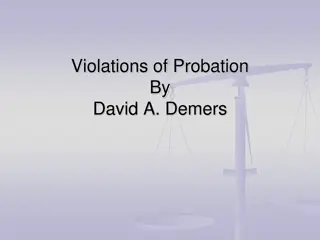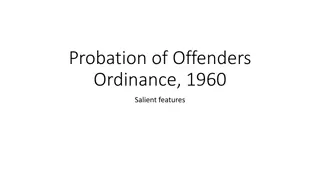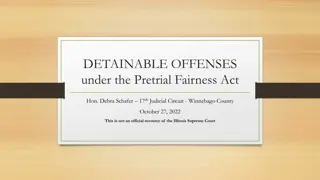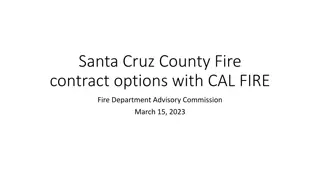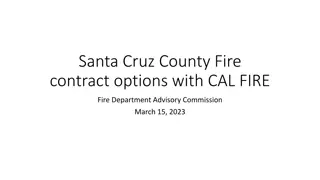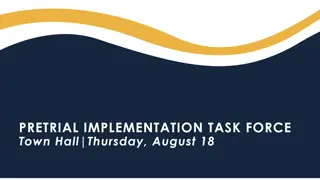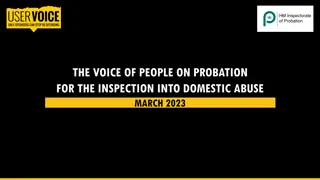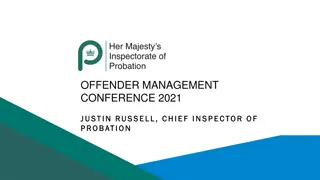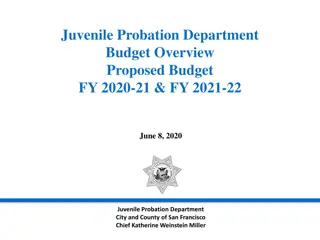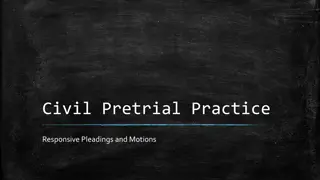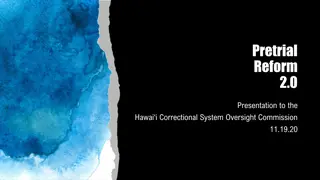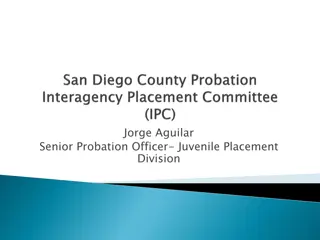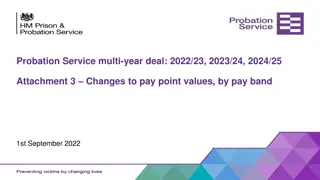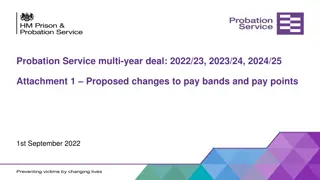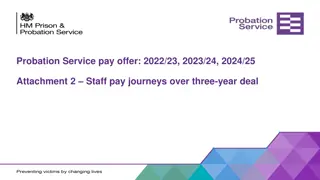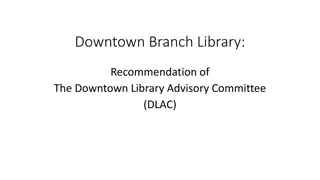Santa Cruz County Probation Department Pretrial Services Overview
The Santa Cruz County Probation Department emphasizes public safety, evidence-based practices, and efficient use of jail space through pretrial services. By implementing actuarial risk tools, providing tailored supervision, and utilizing evidence-based techniques, they aim to reduce pretrial detention, improve compliance, and enhance defendant engagement. Their efforts are crucial in impacting pretrial decisions and reducing recidivism rates post-case conclusion.
Download Presentation

Please find below an Image/Link to download the presentation.
The content on the website is provided AS IS for your information and personal use only. It may not be sold, licensed, or shared on other websites without obtaining consent from the author. Download presentation by click this link. If you encounter any issues during the download, it is possible that the publisher has removed the file from their server.
E N D
Presentation Transcript
Probation Department Pretrial Services Fernando Giraldo Chief Probation Officer May 2017
Pretrial Services Mission: The Santa Cruz County Probation Department maintains its commitment to public safety, researched-based practices, stewardship, and reserving costly and limited jail space for higher risk offenders through alternatives to custody programs.
Pretrial Services Probation Implemented Pretrial Services in 2006 Response to Jail Overcrowding Increase Public Safety Historical commitment to avoid unnecessary pretrial detention for juveniles and adults Many individuals in pretrial detention do not present a substantial public safety or flight risk Jail beds are costly $$ 3
We we doing? What are we doing? We are How 1. Applying actuarial risk tools to predict the likelihood of risk of flight and danger to the community; PSA-Court Assessment Initial Validation complete, full validation by year two. 2. Providing the least restrictive supervision necessary to effectively monitor compliance of release conditions; Decision Making Matrix Began on the more conservative end, modifications made during the last quarter of 2015 to be more in line with national trends. 3. Reminding defendants of their court appearances; Policy 4. Keeping accountability by reporting violations of release conditions which indicate an increased risk of pretrial failure to the court with a recommendation for modifications to mitigate risk; Policy Violation Response Grid 5. Using evidence-based techniques to gain compliance and increase defendant engagementand motivation. Training for staff : Motivational Interviewing and EPICS (skill building); training on Pretrial and Probation EBP 6. Using fidelity measures, data, and evaluation to ensure quality and effectiveness of services and guide decision-making. Multiple Outcomes Measures; staff boosters / re-training. 4
Why it Matters pretrial decisions may impact whether or not a defendant gets sentenced to jail or prison, and for how long; an increased length of pretrial detention for low and moderate risk defendants is associated with an increased likelihood that they will reoffend both during the pretrial period and two years after the conclusion of their case; [pretrial] supervision may reduce failure to appear rates and, when done for 180 days or more, new criminal activity. Laura and John Arnold Foundation Pretrial Criminal Justice Research November 2013 5
PRETRIAL SUPERVISION The level of supervision and conditions of supervision should be based on the defendant s risk level as assessed by the risk assessment and the seriousness of the alleged offense. Blanket conditions should not be applied across all supervised defendants. A formal process for professional overrides which allows for the supervision level to be increased or decreased rather than what is recommended based on the defendant s assessed risk level should be developed and implemented into policy and training. Court reminders should be provided to defendants on pretrial supervision and data should be tracked when the court reminder is provided and if it was received. 6
Being Right-Sized To be right-sized, Pretrial Services added two additional staff in FY14/15. Pretrial Services currently consists of four (4) Deputy Probation Officers, two (2) Probation Aides and one (1) Supervisor. Increased staffing - being right-sized - ensures adequate coverage 7 days a week and fulfillment of our mission to: 7
Public Safety Assessment Court Implemented July 1, 2014 The PSA-Court is a tool that reliably predicts the risk a given defendant will reoffend, commit violent acts, or fail to come back to court with just nine readily available data points. What this means is that there are no time-consuming interviews, no extra staff, and very minimal expense. And it can be applied to every defendant in every case. Laura and John Arnold Foundation November 2013 8
PSA-Court Goals Assure public safety and court appearance. Risk assessments should be used at the earliest point in the process to determine a defendant s risk of pretrial failure. Separately predict failure to appear and new criminal activity . For the first time, predict new violent criminal activity. Identify common non interview dependent factors that equally predict risk across diverse jurisdictions. Optimize use of existing human and financial resources needed to administer risk assessments. Improve overall predictive accuracy. Incorporate the latest pretrial research. 9
Decision Making Framework Goals Provide a framework to guide release & detention recommendations. Identify a proposed release/detention recommendation designed to manage risk identified by the PSA Court in the most effective manner while considering the seriousness of the charge. Promote consistent application of release conditions. Minimize dual system errors (releasing high risk and detaining low risk defendants). 10
Decision Making Framework Guidelines Guides recommendations intended to: Detain, when allowable, highest risk defendants; Release moderate risk defendants with interventions and services targeted to mitigate risk. Why: Moderate and higher risk defendants who were required to participate in supervised pretrial pending trial were more likely to succeed pending trial. Release low risk defendants with minimal or no conditions. Why: Lower risk defendants who were required to participate in supervised pretrial pending trial were more likely to fail pending trial. 11
DMF One Pager (front) Changes have been made to expand the ISOR recommendations to more cases (no longer requiring an underride), leaving Detain as for only the perimeter cases levels of the DMF (this is supported by LJAF and is in line with national trends) 12
DMF One Pager (back) 13
Release Types Own Recognizance (OR) Release with Conditions OR with Conditions (including Alcohol Detection Monitoring Only) Supervised OR (SOR) Intensive Supervised OR (ISOR) includes electronic monitoring and/or alcohol detection monitoring. Staff now trained in the use of GPS, in addition to traditional home detention Release Not Recommended (Detain) 14
DMF Supervision Categories & Standards LOW MODERATE HIGH Supervision Categories OR & SUPERVISED OWN RECOGNIZANCE INTENSIVE SUPERVISED OR OR with Conditions Report by telephone 3x/week Report in person after each court appearance Office contact every month Home visit every 30 days Remain at residence unless going to approved activities (EM Only) Report by telephone 1x/week Report in person after each court appearance Office contact every month Home visit as needed Remain at residence unless going to approved activities (EM Only). Report by telephone 1x/week Report in person after each court appearance Supervision Standards ***Staff now trained to use GPS for those who may not qualify for traditional EM or need a higher level of EM.*** 15
Pretrial Reports Change From Prior Year Pretrial 2012 2013 2014 2015 2016 175 (1st only) Pretrial Assessment Reports Completed 524 1,946 2,457 2,668 + 9%
Adult Probation Division Pretrial and Custody Alternatives Pretrial Supervision Saved $2 Million ($2.6 Million saved when using the updated $115/day jail costs) 25,000 $2,500,000 20,000 $2,000,000 15,000 $1,500,000 10,000 $1,000,000 5,000 $500,000 0 $0 2010 2011 2012 2013 2014 2015 2016 Bed Days Saved Cost Savings ($89.67/day)
Adult Probation Division Pretrial Outcome Measures Monthly Average Annual Total Bed Days Saved Change From Prior Year 2016 Pretrial Reports and Supervision Pretrial Reports Completed 222 2,668 + 8% Average Monthly Caseload (ADP) * 62 355 22,832 + 64% Pre-arraignment Releases ** 64 128 - 320 - 31% WRAP (warrants averted) *** 3 38 1,520 + 58% *ADP during the year: Q1 = 63, Q2 = 57, Q3 = 57, Q4 = 72 **Pre-arraignment releases typically save a minimum of two to five days of jail ***A study conducted by the Vera Institute of Justice in Santa Cruz showed that, on average, probationers who were arrested on bench warrants issued for failing to maintain probation contact spent an average of 40 days in jail.
Adult Probation Division Pretrial Outcome Measures Monthly Average Annual Total Bed Days Saved Change From Prior Year 2016 Pretrial Reports and Supervision Pretrial Reports Completed 222 2,668 + 8% Average Monthly Caseload (ADP) * 62 355 22,832 + 64% Pre-arraignment Releases ** 64 128 - 320 - 31% WRAP (warrants averted) *** 3 38 1,520 + 58% *ADP during the year: Q1 = 63, Q2 = 57, Q3 = 57, Q4 = 72 **Pre-arraignment releases typically save a minimum of two to five days of jail ***A study conducted by the Vera Institute of Justice in Santa Cruz showed that, on average, probationers who were arrested on bench warrants issued for failing to maintain probation contact spent an average of 40 days in jail.
Adult Probation Division Pretrial Outcome Measures Appearance Rate The percentage of supervised defendants who make all scheduled court appearances 1st Half 2014 (VPRAI) 2nd Half 2014 (PSA- Court) Supervised Pretrial 2012 2013 2015 2016 Appearance Rate 92.0% 90.3% 94.2% 91.8% 88.8% 88.2% Goal 85% 85% 85% 85% 85% 85%
Adult Probation Division Pretrial Outcome Measures Safety Rate The percentage of supervised defendants who were not charged with a new offense during their period of pretrial supervision 1st Half 2014 (VPRAI) 2nd Half 2014 (PSA- Court) Supervised Pretrial 2012 2013 2015 2016 Safety Rate 92.5% 90.7% 93.4% 91.0% 95.9% 93.0% Goal 95% 95% 95% 95% 95%
Adult Probation Division Pretrial Outcome Measures Concurrence (Effectiveness) Rate Ratio of court released and detained defendants compared to pretrial s submitted recommendations for release and detention Change from Prior Year Recommendation Followed 2016 Released Detained Recommended for Release 368 48% + 2.4% 342 Recommended for Detention 168 81% - 4% 710 - 2% Recommendation Followed (Total) 66% GOAL 75%


